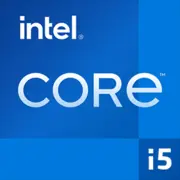Intel Core i5-8279U

Intel Core i5-8279U: モバイルタスク向けの中程度のパワー
2019年のプロセッサー分析を2025年の現実で
アーキテクチャとプロセス技術: 3nm時代のCoffee Lake
2019年にリリースされたIntel Core i5-8279Uは、Coffee Lakeマイクロアーキテクチャと14nmプロセス技術に基づいています。2025年には、これらのパラメータはApple M3やAMD Ryzen 8000の3nmチップの前では古めかしく見えますが、当時はスリムノートパソコンにとって効率的な解決策でした。
- コアとスレッド: Hyper-Threadingのおかげで4コアと8スレッド。ベースクロックは2.4GHz、ターボモードでは最大4.1GHz。
- 統合グラフィックス: Iris Plus Graphics 655は48のEU(実行ユニット)を持ち、最大1.15GHzのクロックで動作します。4Kディスプレイをサポートし、H.265のエンコードが可能で、要求の少ないゲームでは独立したグラフィックスを部分的に置き換えます。
- キャッシュ: 6MBのL3キャッシュは2025年には控えめですが、オフィス作業には十分です。
アーキテクチャの特徴:
- DDR4-2400およびLPDDR3-2136のサポート。
- Intel Quick Sync(ビデオ処理の加速)およびThermal Velocity Boost(低温での自動オーバークロック)技術。
消費電力とTDP: パワーとバッテリー寿命のバランス
TDPは28Wで、i5-8279Uは「パフォーマンスウルトラブック」のニッチに位置づけられます。比較すると、
- 15Wプロセッサー(例: Intel Core i5-1235U)はバッテリー寿命に重点を置いています。
- 45Wチップ(Hシリーズ)はゲーム用ノートパソコン向けです。
ユーザーにとっての意味は?
- i5-8279Uを搭載したノートパソコンはアクティブ冷却が必要ですが、ゲーミングモデルほど大きくはありません。
- 2025年には、このようなシステムは予算セグメントによく見られます(新しいデバイスは$600~$800)。
パフォーマンス: 日常シナリオでの速度
オフィス業務:
- ブラウザ(20以上のタブ)、Word、Excel、Zoomを問題なく処理します。
- 仮想マシン(例: Ubuntu)の実行は可能ですが、4コアの制約があります。
マルチメディア:
- DaVinci Resolveでの1080pビデオの編集: レンダリングはApple M1より2~3倍長くかかります。
- 写真編集ソフト(Lightroom、Photoshop)はRAWファイルの快適な処理が可能ですが、フィルターの適用は遅れが生じます。
ゲーミング:
- Iris Plus 655は2025年のゲームには最低限です。低設定でのFPS例:
- CS:GO — 50~60 FPS
- GTA V — 30~35 FPS
- Fortnite — 40 FPS(720p)
- 現代のAAAタイトル(Cyberpunk 2077、Starfield)はプレイ不可能です。
ターボブーストモード:
- 負荷時にクロックは4.1GHzに上昇しますが、1~2コアのみです。マルチスレッドタスク(例: レンダリング)では、冷却システムが追いつけば3.5~3.8GHzを維持します。
使用シナリオ: 2025年にi5-8279Uが適している人
1. 学生: 学業(タイピング、プレゼンテーション、オンラインコース)や軽い趣味(YouTube、インディーゲーム)に最適です。
2. オフィスワーカー: ドキュメントの作成、ビデオ会議、クラウドサービスを利用する人向けです。
3. 予算に制約のあるユーザー: このCPUを搭載した新しいノートパソコンはRyzen 5 7530Uの類似製品より安価($700~900対$1000+)。
推奨されない用途:
- ゲーマー(独立グラフィックスが必要)。
- ビデオ編集者や3Dデザイナー。
バッテリー寿命: バッテリーはどれくらい持つか?
TDPが28Wの場合、ノートパソコンの稼働時間はバッテリーの容量に大きく依存します。
- 50Whモデルでは6~8時間のウェブサーフィンが可能です。
- 省エネ技術: Intel Speed Shift(動的クロック管理)、Adaptive Brightness(画面の自動調整)。
- フル負荷時(ゲーム、レンダリング)では1.5~2時間のバッテリー寿命です。
アドバイス: 30分で50%充電可能な急速充電機能付きとWindowsの「省エネモード」を選びましょう。
競合他社との比較: Intel対AMDとApple
- AMD Ryzen 5 5500U(2021年): 6コア/12スレッド、Vega 7。マルチスレッドタスクにおいて優れていますが、i5-8279Uはシングルスレッド性能で勝っています。
- Apple M1(2020年): よりエネルギー効率が良く、レンダリングが速いですが、Windowsソフトとの互換性が限られています。
- Intel Core i5-1235U(2023年): 同様のTDPを持つ10nmプロセッサー。ハイブリッドアーキテクチャにより20~30%の性能向上があります。
結論: 2025年にi5-8279Uは、Windowsをサポートし、基本的な性能を求める人にとってお買い得なノートパソコンの選択肢です。
長所と短所
強み:
- 要求の少ないゲームのための良好な統合グラフィックス。
- 日常作業に十分な性能。
- デバイスの手頃な価格。
弱み:
- 古くなった14nmプロセス。
- 現代の競合と比べて4コア。
- アップグレードの制限: このCPUを搭載したノートパソコンは、RAMとSSDが取り外せないことが多いです。
ノートパソコン選びの推奨事項
1. デバイスタイプ: ウルトラブック(例: Dell Inspiron 14)または予算向けラップトップ(Acer Swift 3)。
2. 注目すべき点:
- 冷却: 2つのファンと銅パイプの方がパッシブよりも良いです。
- メモリ: 最低8GB、可能なら16GB。
- ストレージ: SSDのみ(NVMeが優先)。
- 画面: 輝度300ニトのフルIPSパネル。
2025年のモデル例:
- Lenovo IdeaPad 5 (2024): 14インチディスプレイ、16GB RAM、512GB SSD — $750。
- HP Pavilion Aero 13: 重量1kg、AMOLEDディスプレイ — $899。
最終結論
2025年のIntel Core i5-8279Uは、手頃な価格で信頼性のあるノートパソコンを求める妥協のないユーザー向けです。仕事、学習、軽いメディア消費に適していますが、ゲームやプロフェッショナルなタスクに期待を寄せないでください。主な長所は、手頃さ、携帯性、そして時の試練に耐えた安定性です。予算が$800に制限され、ソフトウェアの要件が最小限の場合、このプロセッサーは注目に値します。
基本
CPUの仕様
メモリ仕様
GPUの仕様
その他
ベンチマーク
他のCPUとの比較
ソーシャルメディアで共有する
または当サイトへのリンクを追加
<a href="https://cputronic.com/ja/cpu/intel-core-i5-8279u" target="_blank">Intel Core i5-8279U</a>